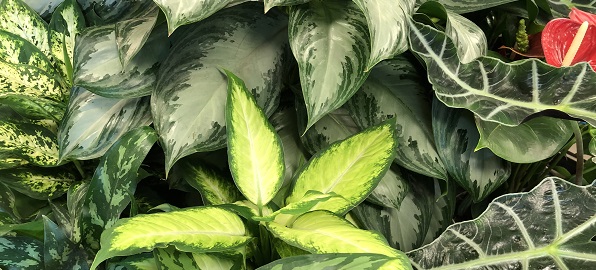Once you have chosen a houseplant which is appropriate for the light conditions in your location, the single most important aspect of their care is knowing how to water correctly. When at all possible, double potting (setting a nursery pot inside a decorative pot) is the most effective method of potting. As long as the nursery pot is manageable, it can be moved outside or to a sink or bathtub to water the plant. It is very important to be able to water the plant in a location where the pot can drain. In this way, sufficient water can be applied to wet the entire root system.
In contrast, when we attempt to water a plant without moving it, we are limited as to the amount of water that can be applied before it runs out and fills the saucer. Often this leaves the top part of the soil with dry pockets. The excess water in the saucer is then re-absorbed, filling the pore spaces meant for oxygen. The top roots dry out and the bottom roots rot! That said, it is often impossible to move a large plant outside to water it-we need to get creative to prevent drying and rotting roots. A turkey baster can be used to siphon off excess water so it is not absorbed. The water can be poured back through the soil several times if necessary in order to wet it sufficiently. If this is done correctly, it will lengthen the intervals between waterings.
The next aspect about watering is “How often?” There is no set schedule for watering indoor plants, although after a period of time, you will get a feel for when your plant needs watering. Be sure to ask whether your plant is best kept moist, allowed to approach dryness, or let dry completely between waterings. Feeling the soil or the weight of the pot (with the smaller pots) is a good indicator of how much water is still in the soil. Moisture meters may be helpful as well.
Few houseplants, except cactus, will tolerate direct sun coming through a window. Most grow best in bright filtered light. Be careful about setting a plant near a heat or AC vent-the dry air can take water from the leaves and make ends turn brown. Some plants (Dracaenas and Spider Plants) are sensitive to fluoride in our water. The tips of the leaves may brown. Saving rainwater or watering with distilled water is best for these plants.
Plants should be checked weekly for insects and disease. Samples should be taken to your Garden Center and plants should be treated ASAP. Most houseplants do well if fertilized once in the spring and twice during the summer. Vining plants should be cut back periodically to promote branching. Leaves may be rinsed periodically with water to keep dust from blocking light from the leaf.
